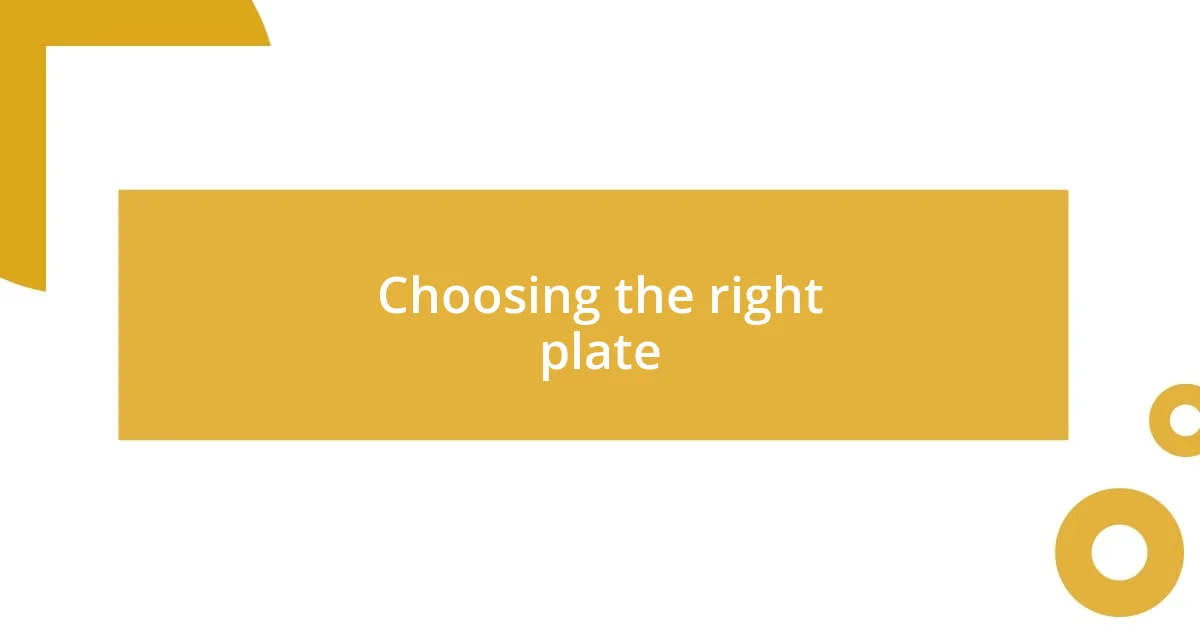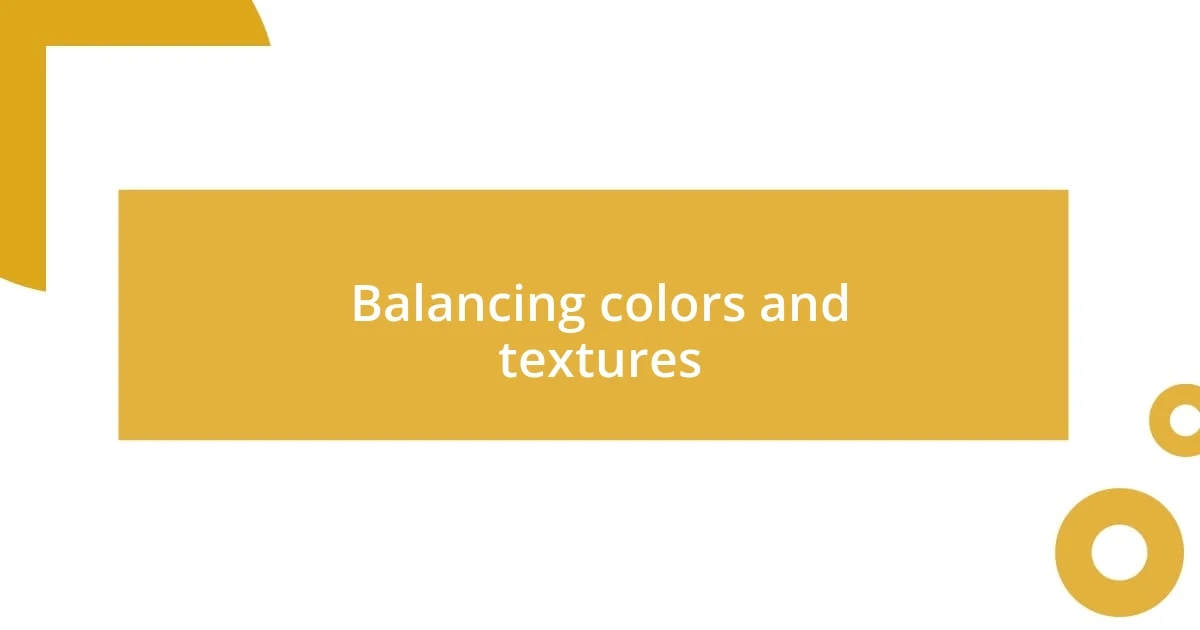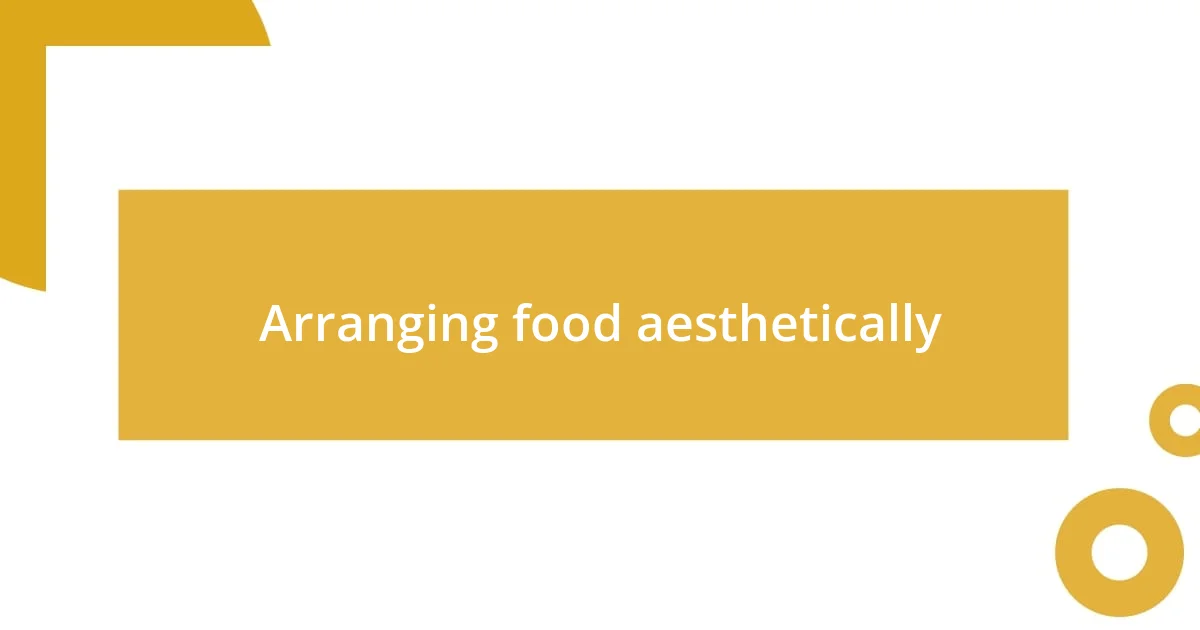Key takeaways:
- Effective plating involves balancing colors, textures, and negative space to create visual harmony and enhance the dining experience.
- Choosing the right plate—considering color, size, and material—can elevate the presentation and emotional impact of the dish.
- Personalizing plating style through unique vessels, storytelling with colors, and incorporating cultural elements makes each meal a reflection of the cook’s identity.

Understanding plating fundamentals
When I first delved into plating, I was amazed by how a simple arrangement could elevate a dish from ordinary to extraordinary. I remember plating a vibrant beet salad, arranging the beets in a spiral, and stepping back to admire the colors. That moment made me realize how fundamental composition is in plating—balancing colors, shapes, and textures can create visual harmony that draws people in.
Texture plays an essential role, too. Have you ever experienced that “wow” factor when you bite into a dish that looks as good as it tastes? For me, the contrast between a crunchy garnish atop a creamy sauce not only tantalizes the palate but also adds a layer of visual appeal. As I’ve experimented with different textures, I’ve learned that incorporating various components, like crispy elements or smooth purees, can transform a plate into an engaging experience.
Another critical aspect of plating fundamentals is the use of negative space. I once faced the challenge of plating a dish where the ingredients seemed to fight for attention. It struck me that allowing empty space on the plate let the vibrant colors of the food shine. This approach not only helped to focus the viewer’s gaze but also imparted a sense of elegance and simplicity that I had previously overlooked. Have you tried using negative space in your plating? It can make all the difference!

Choosing the right plate
Choosing the right plate is a crucial step in the plating process. I still remember selecting my first set of plates; the right choice transformed the way I presented my food. I often opt for white plates, as they serve as a blank canvas, allowing the colors of the dish to pop. Have you noticed how a vibrant sauce looks even more enticing against a plain background?
The size of the plate matters too. Using a smaller plate can create a beautiful illusion of abundance, making even a modest portion feel generous. I once plated a delicate quinoa dish on a larger plate, and it felt lost and unappealing. The next time, I switched to a smaller plate and amplified the dish’s visual impact—sometimes, less truly is more.
Material also plays a fascinating role. I personally love the rustic feel of ceramic plates; they add a touch of warmth to the meal. In contrast, sleek glass or metal plates can impart a modern vibe. The materials you choose can evoke different emotions, turning a simple everyday meal into a special occasion. What feeling do you want to convey with your plate choice?
| Plate Type | Features |
|---|---|
| White Plates | Enhance colors; versatile backdrop |
| Smaller Plates | Creates illusion of abundance; draws focus |
| Ceramic | Warmth and texture; rustic feel |
| Glass/Metal | Modern and sleek; contemporary aesthetic |

Balancing colors and textures
Balancing colors and textures on a plate is like a dance; it’s about finding the right rhythm. I remember plating a dish featuring roasted vegetables alongside a delicate herb sauce. As I stacked the vibrantly colored veggies, I felt a rush of excitement. The earthy tones of the roasted carrots and Brussels sprouts danced beautifully against the bright green sauce, creating a visual feast that I couldn’t wait to share. It’s fascinating how the combination of different colors not only makes a plate look appealing but can also evoke emotions—like warmth and comfort.
When it comes to textures, I’ve discovered that they can transform a dish from simple to sensational. Here’s how I balance colors and textures:
- Layering: I often arrange a creamy puree at the base, topped with roasted or grilled elements for contrast.
- Contrasting Colors: Think deep purples with bright greens or vibrant reds next to soft yellows. It catches the eye.
- Varied Shapes: Use slices, cubes, and dollops to break monotony and create interest.
- Crunchy Toppings: Adding a sprinkle of nuts or seeds on a smooth dish can boost both texture and flavor.
- Fresh Garnishes: Fresh herbs or microgreens don’t just add a pop of color; they offer a delightful crunch, too.
This thoughtful combination pulls the dish together, creating an inviting artistry that makes each meal memorable.

Arranging food aesthetically
Arranging food aesthetically goes beyond mere presentation; it’s an opportunity to tell a story. One time, I plated a seafood paella and decided to fan out the shrimp and mussels around the edges. The vibrant yellows and oranges of the saffron-infused rice mingled beautifully with the deep blue of the dish. As I observed it, I felt a surge of joy, realizing that the way I arranged those elements invited my guests to dive into the meal visually before even tasting it. Have you ever noticed how much more exciting a dish feels when it looks like a work of art?
Creating visual height on a plate can also add an engaging dimension. I’ve had great success stacking ingredients, like grilled chicken on a bed of quinoa, adding a vibrant herb sauce on top. Not only does it create an inviting focal point, but it also encourages diners to experience varied tastes and textures in each bite. There’s something special about that verticality; it’s as if you’re saying to your guests, “Take a closer look!”
Don’t underestimate the power of garnishes; they’re the finishing touches that can elevate your meal to another level. A simple sprinkle of microgreens or a dash of edible flowers can transform a palette of colors into an enticing visual explosion. I once added a few bright nasturtiums to a dish of roasted red pepper soup, and the vibrancy they brought was nothing short of magical. Have you ever felt that transformation when a garnish brings an entire dish together? It’s these little details that make the experience unforgettable.

Incorporating height in plating
Incorporating height in plating can elevate your culinary creation from ordinary to extraordinary. I remember plating a layered dessert where I stacked rich chocolate mousse, a tangy raspberry coulis, and fluffy whipped cream in a tall glass. The moment I saw the towering layers, I knew I created a centerpiece that was not just enticing but also playful, inviting my guests to dig in and enjoy the delightful contrast in flavors. Have you ever looked at a dish and just wanted to dive into it because of its impressive height?
One effective method I’ve discovered is using different shapes and sizes of ingredients to create dramatic elevations. For example, I once used grilled vegetable skewers standing tall on a bed of creamy polenta. The skewers not only provided visual height but also a fun, hands-on way for my guests to engage with the meal. I find that this kind of presentation elicits curiosity—people tend to ask how I made it, and that’s where the joy of sharing my cooking journey comes in.
Finally, garnishes aren’t just for decoration; they can add an element of height too. When I topped a bowl of soup with a delicate tangle of fried leeks, the contrast was stunning, with the crispy texture reaching upward and drawing the eye. It’s amazing how something as simple as a garnish can create a layered effect. Does it make you wonder how you can change perceptions of a dish with just a few thoughtful choices? That’s the beauty of plating — it opens up a world of creativity and exploration with every meal.

Adding finishing touches
Adding those finishing touches to a dish can be truly transformative. I remember a time when I drizzled a homemade balsamic reduction over a caprese salad. The glossy finish not only created a visual appeal but also added a sweet-tart punch that elevated the overall flavor profile. It just goes to show how a simple addition can make a dish sing—have you found a finishing touch that turned a good meal into an unforgettable one?
Another element I love to play with is the contrast in textures. I often finish a dish with a sprinkle of crispy shallots or toasted nuts, which provide that delightful crunch against softer elements. I once whipped up a creamy risotto topped with a handful of crunchy bacon bits. As my family dove in, I could see their surprised satisfaction—texture can add a whole new layer of enjoyment. Isn’t it interesting how the smallest details can completely change the experience?
Finally, I can’t stress enough the impact of color in those finishing touches. A bright swirl of herb oil can take a plate from blah to beautiful! I once accented a rich pasta dish with vibrant, green basil oil, and the way it popped against the warm pasta was a sight that drew gasps from my guests. It created an excitement that was almost tangible. Do you think something as simple as a splash of color could inspire creativity in your own plating adventures? Remember, your culinary creations deserve every bit of brilliance you can bring to the table!

Personalizing your plating style
Personalizing your plating style is all about infusing your unique personality into each dish. I recall a time I opted for a rustic wooden board instead of a traditional plate when serving a cheese and charcuterie spread. This choice not only set a casual, inviting tone but also ignited conversations among my guests, who loved the tactile experience of reaching for what they wanted. Have you ever considered how the vessel you use can speak volumes about your culinary voice?
I also believe in the power of storytelling through colors and themes, as I found out during a summer garden party. I decided to create a vibrant, Mediterranean-inspired spread featuring roasted red peppers, olives, and fresh herbs. The colors alone sparked joy and captured the essence of the season, transforming the table into a lively canvas. It made me wonder—how does the visual storytelling of your dishes reflect the stories you want to share?
Incorporating elements from my heritage has also been key to personalizing my plating. For instance, when I plated a traditional mole dish, I added a sprinkle of crumbled queso fresco and a vibrant side of grilled corn, reminiscent of family dinners growing up. This not only honored my roots but sparked nostalgia among my guests, stimulating conversations about their own memories. Isn’t it extraordinary how plating can evoke emotions and connect people over food? Personal touches in your presentation truly make each meal a celebration of who you are and where you come from.













